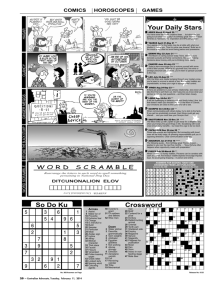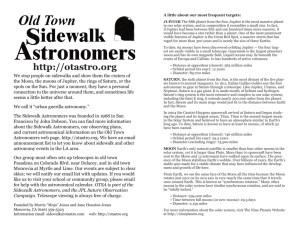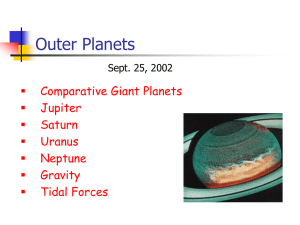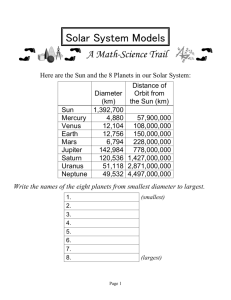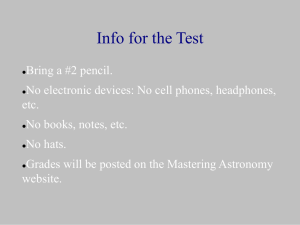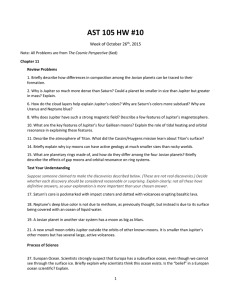ASTRO/PHYS 1040: Elementary Astronomy, Dr. Sohl, Homework
advertisement
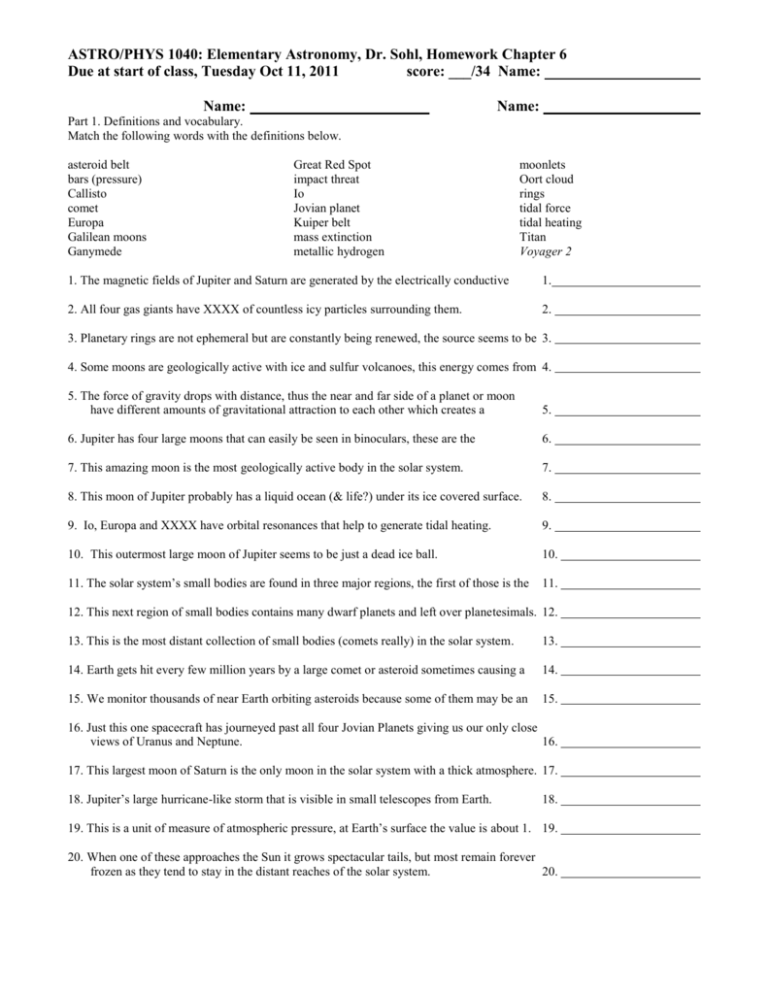
ASTRO/PHYS 1040: Elementary Astronomy, Dr. Sohl, Homework Chapter 6 Due at start of class, Tuesday Oct 11, 2011 score: ___/34 Name: Name: Name: Part 1. Definitions and vocabulary. Match the following words with the definitions below. asteroid belt bars (pressure) Callisto comet Europa Galilean moons Ganymede Great Red Spot impact threat Io Jovian planet Kuiper belt mass extinction metallic hydrogen moonlets Oort cloud rings tidal force tidal heating Titan Voyager 2 1. The magnetic fields of Jupiter and Saturn are generated by the electrically conductive 1. 2. All four gas giants have XXXX of countless icy particles surrounding them. 2. 3. Planetary rings are not ephemeral but are constantly being renewed, the source seems to be 3. 4. Some moons are geologically active with ice and sulfur volcanoes, this energy comes from 4. 5. The force of gravity drops with distance, thus the near and far side of a planet or moon have different amounts of gravitational attraction to each other which creates a 5. 6. Jupiter has four large moons that can easily be seen in binoculars, these are the 6. 7. This amazing moon is the most geologically active body in the solar system. 7. 8. This moon of Jupiter probably has a liquid ocean (& life?) under its ice covered surface. 8. 9. Io, Europa and XXXX have orbital resonances that help to generate tidal heating. 9. 10. This outermost large moon of Jupiter seems to be just a dead ice ball. 10. 11. The solar system’s small bodies are found in three major regions, the first of those is the 11. 12. This next region of small bodies contains many dwarf planets and left over planetesimals. 12. 13. This is the most distant collection of small bodies (comets really) in the solar system. 13. 14. Earth gets hit every few million years by a large comet or asteroid sometimes causing a 14. 15. We monitor thousands of near Earth orbiting asteroids because some of them may be an 15. 16. Just this one spacecraft has journeyed past all four Jovian Planets giving us our only close views of Uranus and Neptune. 16. 17. This largest moon of Saturn is the only moon in the solar system with a thick atmosphere. 17. 18. Jupiter’s large hurricane-like storm that is visible in small telescopes from Earth. 18. 19. This is a unit of measure of atmospheric pressure, at Earth’s surface the value is about 1. 19. 20. When one of these approaches the Sun it grows spectacular tails, but most remain forever frozen as they tend to stay in the distant reaches of the solar system. 20. Part 2. Questions (2 points each) 1. Uranus and Neptune do not contain liquid metallic hydrogen because they a. are not massive enough. b. are not rich enough in hydrogen. c. rotate too slowly. d. are too far from the sun. e. have magnetic fields that are much too weak. 1. 2. Most evidence seems to indicate that the dinosaurs were driven into extinction by a large impact about 65 million years ago off of the Yucatan Peninsula. Aside from the immediate devastation from the impact what other, longer term, effects would have made life on Earth a challenge, probably being the demise of the dinosaurs? 3. Why is Io more volcanically active than our Moon? 4. The graph below plots the escape velocity of several solar system objects along the vertical axis and the surface temperature along the horizontal. The lines plotted in the figure are the average speeds of gas particles as a function of temperature for various gases. Which of the objects in this diagram has the greatest surface temperature? (This question and graph is from Dr. Jim Roberts at the Univ. of North Texas.) 4. ____________________ 5. In the graph above, Earth’s Moon would be way off to the right. Why does Titan have a thick atmosphere but Earth’s Moon has almost zero atmosphere? 6. In the graph above, what gases could Titan be expected to retain on its surface? 7. The cores of Jupiter and Saturn are probably mostly solid rock, but the cores of Uranus and Neptune are most likely…

